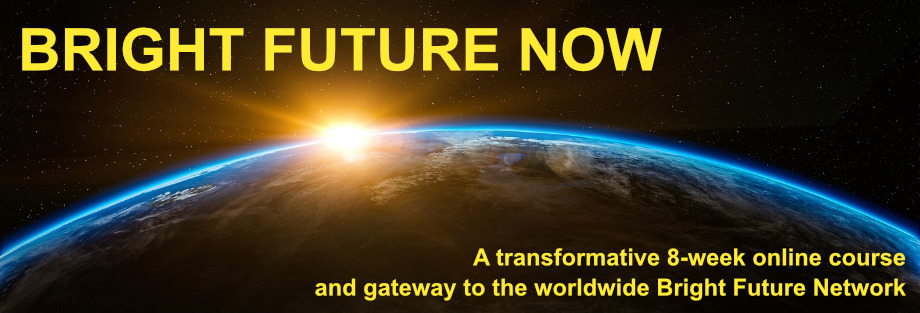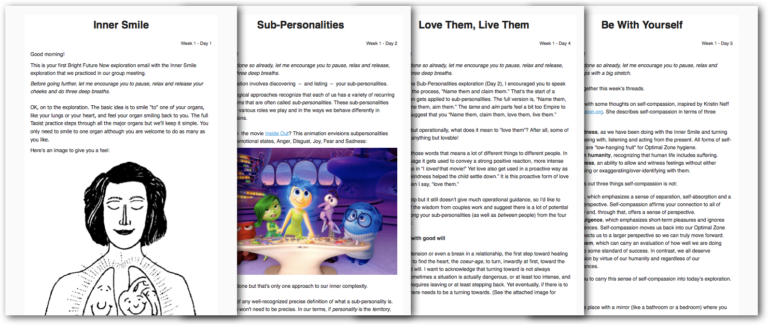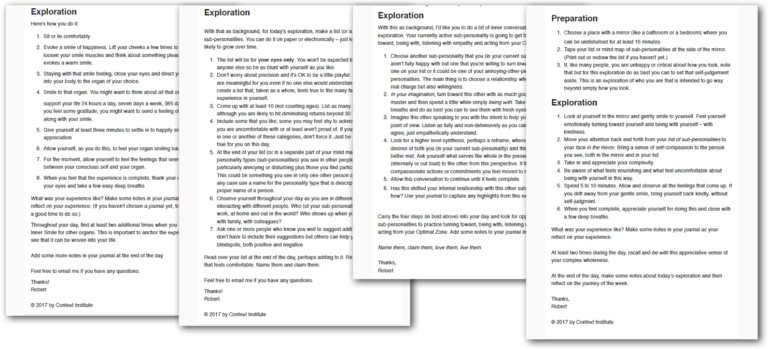Overview ● Content ● Process ● Network ● Pricing ● Registration ● FAQ ● Testimonials

The Process
Bright Future Now is innovative in its process as well as its content. Some of the unusual threads we weave together to support your deep learning are:
- keeping each cohort limited to a maximum of 21 people so the group retains a personal, safe, human-scale feel
- creating an online experience that is remarkably natural, connected and easy
- supporting and respecting your unique inner sense of what’s on your growing edge – you choose, with whatever level of support you want, how you engage with the content
- focusing on your learning experience rather than your external performance – there are no tests, no written assignments, nothing to hand in
- integrating the course into your daily life and normal context, rather than offering it at, say, some retreat center – you can apply it right away and what you gain from the course is more likely to stay with you.
In the rest of this page, we’ll describe more of the threads in process. We’ll go into:
Pre-Course Activities
The official start-date for the course is the date of the first group meeting but there are important pre-course activities that need to happen in the month or so before then so that you can get the best experience from the course.
-
You start with an Orientation Call – a video call using Zoom, which is our interactive platform. That call connects you to one of the program guides and, among other things, introduces you to our online forum.
-
Next is participating in our online forum, where you will post your self-introduction and photo. These help the group start to know itself and form weeks before the first weekend meeting. We use the forum for a lot of pre-course information sharing and discussion.
-
Then watch the three Foundation Stones presentations, which provide important context, including key concepts, for the course and for the shared language we use in the network.
Each presentation runs a little over an hour and a half but is split into 20-minute sections for easier viewing. They are publicly available via either context.org or youtube:- What Time Is It? (on context.org – on youtube)
- Human Operating-System Literacy (on context.org – on youtube)
- Systems Literacy (on context.org – on youtube)
The course is quite different in style from, but complementary to, the presentations. Each without the other is a bit like the sound of one hand clapping.
- In the last three weeks before the first weekend meeting, we take care of setting up meeting times for the interactive part of the course. Everyone in the group participates in setting the times for the weekend meetings, your ally will reach out to connect with you and arrange your first meeting, and you’ll be part of scheduling your first triad meeting.
These things won’t take many minutes of your time but they always seem to work best when we allow a spacious amount of calendar time for the necessary back-and-forth communications to complete.
We like to think of these pre-course activities in the spirit of the course being a journey. If this were a physical journey, you’d have quite a bit of pre-travel preparation to do. You might need to get travel documents (passport, visa, etc.). You might want to do some study about where you are going and learn some of the language. You would want to make sure you had all the necessary gear for hiking, swimming or whatever.
Our virtual journey doesn’t require a passport but it has its own vital set of pre-journey activities as described above.
Weekly Rhythm
The course runs for eight weeks, as illustrated in the following diagram: three initial weeks with content, an “integration” week in the middle and four final weeks with content. (For specifics on the content of each week, please see the Content page.)
Each of the seven content weeks follows a similar rhythm:
The morning emails come Monday through Friday at 4 AM in your local time so they’re waiting for you whenever you choose to turn to them. The default rhythm is to read them in the morning and then weave their ideas and experiences into your day.
We encourage you to have a journal. It can be paper or electronic, whatever you like. It’s totally private to you. We’ll never ask you to share anything out of it. It’s helpful to have it to gather up your reflections at the end of each day because the next day will come with another email and a whole new exploration. That said, it’s totally up to you how much you use your journal.
Communications Channels
We use three communications channels: morning emails, interactive online video calls and our private interactive online forum.
Let’s look at each channel:
Morning Emails
The morning emails, together with the presentation videos, provide the content for the course. You get to choose what out of this content is valuable for you. There are no tests, no written assignments, no external standards you need to meet.
Indeed, I encourage you to put your outer-directed, good-student habits aside and allow yourself to approach the course in your own unique, inner-directed way. Especially during the first three weeks, let the course to be a gift from your adult-self to your child-self … and from your child-self to your adult-self.
Here are some examples of emails from the first week.

Each one has some initial text describing the concepts for the day and then, at the end of each email, there is what we call an Exploration.

I also like to call these treasure-hunt instructions. These Explorations are the experiential heart of the course. Sometimes they are like a guided meditation, sometimes they are just a request to reflect on how the concepts have, are or could be part of your life. In Week 5, the Systems and Habits week, they involve the next steps for diagrams you’ll be developing. There is quite a bit of diversity in the Explorations throughout the six content weeks.
Interactive Video Calls
If the emails are about content and explorations, the video-call channel is about relationships and experiencing the content through the eyes of your fellow explorers. The course is the gateway to the Bright Future Network, so your relationships with your fellow explorers often extend well beyond the eight weeks. The video-call part of the course provides a gentle beginning to these connections.
Triads
You’ll be in a small group with normally two other explorers (although sometimes one) to meet once a week. Your small group will determine when you meet and for how long, although it’s typically 40 to 60 minutes. Each group will also self-facilitate.
You will actually be in two of these small groups, sequentially: one for the first half and another for the second half of the course. You will get to know a number of your fellow explorers in some depth through these small group meetings.
Ally
Next, let’s go to your ally, a graduate from a previous course who’s volunteered to be a support for you and your experience during the course. Your ally isn’t meant to be a content expert or a tutor or a coach – just someone who’s been down the path before.
I like to say that with your ally, you get 100% of the attention-share; in your triad, you get one-third of the attention-share; and in the weekend meetings, you get about a tenth of the attention-share. Your ally also begins to connect you into the network of graduates.
You keep the same ally for the whole eight weeks, so your ally provides continuity.
Weekend Meetings
We have both a Saturday and a Sunday group meeting with about 10 explorers in each meeting. You join in just one of these. The exact time depends on the group and its time zones. You will have a voice in the times for your cohort. Unless your time zone is at the far end of the range, you will be able to choose, week to week, which day you will attend.
The heart of these meetings is the round of reflections, by you and your fellow explorers, on your experience of the week. Your Guides facilitate the meetings, answer questions, orient you to the coming week and deal with logistics. There is no “content” presentation. That’s all in the emails and the presentation videos.
We record these meetings and make the recordings available only to your cohort and your support team (the guides and allies for your cohort). This is helpful when, as inevitably happens, someone can’t make either weekend meeting. They can still watch the video and thus stay current. People also like to watch the video of the meeting they weren’t in. They get to know more people that way, and the reflections and questions are often quite insightful.
Online Forum
Our private online forum is our third channel – one we use to provide supplemental resources, work out logistics and discuss the content.
Before the course begins, the forum is the place where everyone posts a self-introduction. We also use it to provide orientation and answer questions. Once the course starts, each week gets its own special thread.
You’ll get introduced to the forum and get your login info during your Orientation Call.
How much time is needed?
It varies from person to person. We estimate generally a total of 7 to 10 hours per week of flexible time – less time than many people spend on social media each week.
Here are the details:
- 15 minutes or less to read each Morning Email, which comes Monday through Friday for seven of the eight weeks; less than 30 minutes to work with the explorations at the end of each Morning Email. You do these things when it fits into your schedule.
- 40 minutes or so each week for your small group call. You participate in scheduling when that call will happen.
- 30 to 60 minutes each week for your call with your Ally. You participate in scheduling when that call will happen.
- 90 minutes each week for the Weekend Meetings. You participate in scheduling when that call will happen.
The course is designed to fit into the lives of busy people while it provides deep learning. It works best when you carry the concepts and experiences from the course into your daily life. In this sense, it’s more a matter of mental bandwidth than of minutes.
Join us in this journey to the future
If you’d like to learn more, please visit the other pages that provide an overview, go into depth on the content and describe the network of course graduates.
If you’re ready, we’d love to have you join us.


